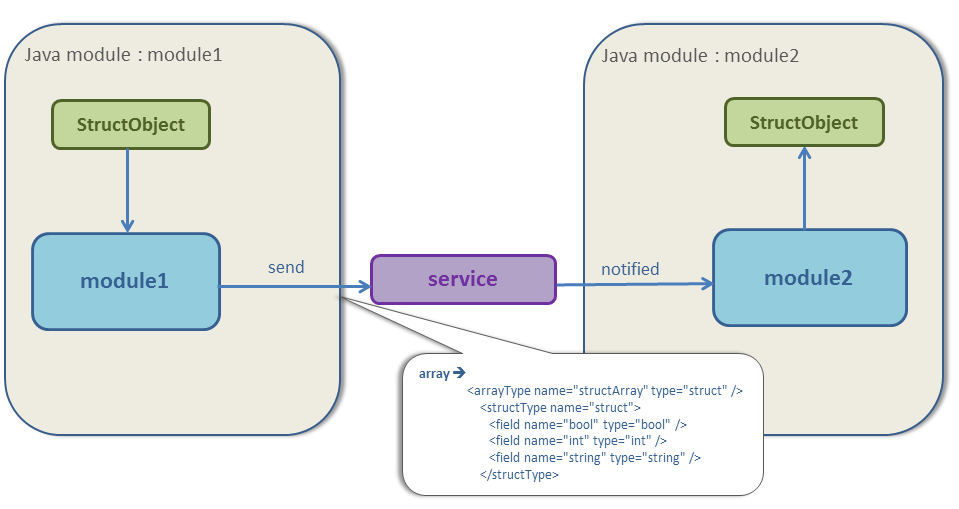Home
Categories
Dictionary
Glossary
Download
Project Details
Changes Log
What Links Here
FAQ
License
Type annotation mapping tutorial
1 Overview
2 XML configuration
2.1 Services definition
2.2 Types definition
2.3 Applications definition
3 Creating the structure associated class
4 Code the applications
4.1 Code the first module
4.2 Code the second module
5 See also
2 XML configuration
2.1 Services definition
2.2 Types definition
2.3 Applications definition
3 Creating the structure associated class
4 Code the applications
4.1 Code the first module
4.2 Code the second module
5 See also
This tutorial shows how to map a data type to a class through annotations.
The structure which is the type oea each element in the array contains three fields:
We will map this structure to a class to be able to set and get the value of the array without having to set indivicually each field foe each structure element:

We define the associated types in a
Overview
Suppose the we want to specify two modules which exchange one data which is an array of structure.The structure which is the type oea each element in the array contains three fields:
- A boolean
- An int
- A String
We will map this structure to a class to be able to set and get the value of the array without having to set indivicually each field foe each structure element:

XML configuration
Services definition
We define only one service in aservices.xml XML file:<services> <event name="service" > <data name="array" type="structArray" /> </event> </services>
Types definition
The data is an array for which each element is a structure.We define the associated types in a
types.xml XML file:<simpleType name="bool" baseType="boolean" /> <simpleType name="int" baseType="int" /> <simpleType name="string" baseType="string" /> <arrayType name="structArray" type="struct" /> <structType name="struct"> <field name="bool" type="bool" /> <field name="int" type="int" /> <field name="string" type="string" /> </structType>
Applications definition
We define our two applications in anapplications.xml XML file:- The first application contains one module which sends the Service
- The first application contains one module which receives the Service
<applications> <application name="appli1"> <deployment> ... </deployment> <modules> <module name="module1"> <implementation path="..." > <initEntryPoint method="init" /> <startEntryPoint method="start" /> </implementation> <interfaces> <push service="service" attach="attach"/> </interfaces> </module> </modules> </application> <application name="appli2"> <deployment> ... </deployment> <modules> <module name="module2"> <implementation path="..." > <defaultReceiveEntryPoint method="subscribe" /> </implementation> <interfaces> <subscribe service="service"/> </interfaces> </module> </modules> </application> </applications>
Creating the structure associated class
We will create a class which will hold the fields of our structure:@DataTag public static class StructObject { @FieldTag(field = "bool") public boolean bool = false; @FieldTag(field = "string") public String str = ""; @FieldTag(field = "int") public int val = 0; }The annotations specify that:
-
@DataTag: the class maps a type -
@FieldTag: the class member maps a structure field
Code the applications
Code the first module
ServiceInstance service; public void init(Module module) { service = module.getProviderService("service"); } public void start() { Data data = service.getData("array"); StructObject obj = new StructObject(); obj.bool = true; obj.str = "toto"; obj.val = 2; list.add(obj); data.setValue(list); service.invoke(); }
Code the second module
public void subscribe(ServiceInstance service) { Data data = service.getData("array"); StructObject obj = new StructObject(); obj.bool = true; obj.str = "toto"; obj.val = 2; list.add(obj); List<StructObject> array = (List<StructObject>)data.getValue(StructObject.class); }
See also
- Mapping a data type to a class: This article explains how to map a data type to a class through annotations
- Data manipulation: This article explains how to get datas and set data values
×
![]()
Categories: concepts